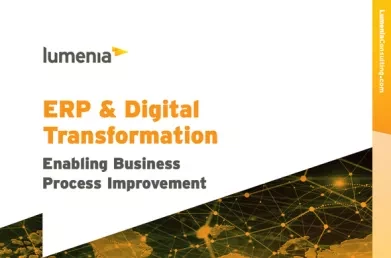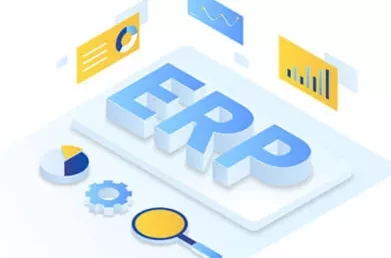The Human Element versus AI in ERP Selection
Why Real-World Expertise and Judgement Still Matter
AI can accelerate elements of an ERP selection, like identifying products and vendors for consideration and sense-checking requirements, but success still depends on human expertise: domain knowledge, sound judgement and the in-person conversations that uncover real priorities, risks and trade-offs, while building internal buy-in for what comes next.
Why this matters
ERP selection is a high-stakes decision that shapes business processes, controls and data for years to come. With the recent surge in generative AI, businesses are increasingly seeking to automate more of the journey. The reality? AI is a powerful assistant – not a decision maker. It can help you move faster, but the informed, context-rich decisions that drive long-term value and implementation success should remain in human hands.
How AI can support ERP selection
AI can play a valuable supporting role in ERP selection by accelerating routine tasks and enhancing consistency. Examples include:
- Market scanning for a longlist – Large Language Models (LLMs) and search tools can rapidly compile a view of mainstream and niche ERP solutions aligned to sector-specific keywords, deployment models and rough scale, helping you assemble or compare against a reasoned longlist.
- Requirements review – AI can de-duplicate, tidy and classify documented requirements. It can flag overlaps, convert rough text into consistent “must-have” and “should-have” statements, and propose gaps to consider. This is efficient, especially when preparing Requests for Information or Proposal (RFIs/RFPs). However, there's a risk that AI simply reinforces current-state thinking. Human challenge is important, or you may miss opportunities to adopt best practices or embrace "fit-to-standard" approaches that can drive real process transformation.
- First-pass comparisons – Given structured data, AI can produce helpful matrices and highlight obvious mismatches against must-have requirements. However, this should be treated as the starting point for evaluation, not the final verdict.
These tools can save time and bring structure, but they work best when paired with human oversight – framing the right questions, validating the outputs, and focusing attention on the differentiators that truly matter.

Where over-reliance on AI creates risk
1. Hallucinations about ERP features, capabilities and costs
LLMs are probabilistic. When the data they're working with is ambiguous or sparse, they can fabricate plausible-sounding answers about solution coverage, deployment models, integration mechanisms and product roadmaps. In ERP selection, these hallucinations can mislead, impacting your shortlisting decisions and budgetary assessments.
When it comes to Total Cost of Ownership (TCO), external costs such as licensing and partner implementation are particularly difficult to ascertain through desktop research, limiting the likelihood of obtaining accurate estimates from LLMs. Internal costs associated with business resource allocation, ongoing upgrades and support are even harder for AI to estimate.
Mitigation: Consultants and internal SMEs must interrogate, validate and supplement AI-generated claims through independent research, vendor engagement, product documentation, live demonstrations and real-world reference checks.
2. Failing to identify combinations of applications and platforms
Many modern ERP landscapes blend core ERP functionality with add-on modules, specialised applications (e.g., Warehouse Management Systems, Configure Price Quote and Manufacturing Execution Systems) and complementary platforms (e.g., for integration, business intelligence and low-code development). Currently, AI struggles to identify and evaluate nuanced options like “ERP system X" vs. "ERP system Y + best-of-breed system Z” against criteria such as requirements and process fit, integration complexity, master data management, licensing and roadmap resilience.
Mitigation: Technical and process experts should model to-be flows, map master data and transactional data ownership, and assess integration scope, testing burden and support implications, thoroughly evaluating the options with direct vendor input.
3. Overreliance on outdated or optimistic marketing content
Public information does not always reflect reality – or reflects tomorrow’s roadmap as if it were today’s standard. AI that relies on public web sources risks surfacing inaccurate information, such as ERP capabilities that are immature, add-on only, or region-specific, aspirational vendor claims about the depth of their industry expertise, and pricing that omits the required modules, environments or support tiers for a particular implementation.
Mitigation: In practice, market familiarity and experience are key to identifying which claims need proof. These should be corroborated through structured RFI/RFP processes, scripted demonstrations focused on differentiator scenarios and targeted reference calls. Always demand verifiable evidence – especially when AI-generated content is involved.
4. Weak ERP partner recommendations
Selecting an implementation partner is as consequential as choosing an ERP product. Our experience is that AI-driven partner recommendations tend to miss critical qualifiers: sector experience, local presence, delivery capacity at the required scale, methodology fit, tenure of the delivery team and cultural alignment with your business. As with product research, AI is equally prone to hallucinations and gullibility when it comes to partner identification.
Mitigation: Human judgment and diligence reach beyond web content and brochures. The selection team should speak directly with potential partners to understand their suitability, review written responses, conduct site visits or calls with relevant past clients, interview members of the proposed delivery team, and actively discuss approaches to project delivery, resourcing and governance.
The human skills that make a difference
While AI can support the mechanics of ERP selection, it is human expertise that ensures the process is grounded in business reality. From strategic framing to partner evaluation, these are the elements that shape better decisions and smoother implementations:
- Strategic framing before ERP selection – Before diving into product comparisons, organisations must often make a more fundamental decision: whether to retain, replace or reconfigure their ERP landscape. This requires a clear understanding of business drivers, pain points, and future needs – areas where human insight is indispensable.
- Facilitation and stakeholder alignment – Interviews and workshops surface real objectives, constraints and non-negotiables. Skilled facilitators can reconcile competing priorities across finance, operations, supply chain, commercial and IT. No tool can shortcut this work.
- Pattern recognition from real-world experience – Experienced resources can spot common differentiator requirements like complex discount structures, multi-entity intercompany flows and engineer-to-order variability and understand which systems and partners are best equipped to handle them.
- Cultural fit assessment – While an implementation partner may be competent on paper, the proof is in their behaviours. Face-to-face interaction through briefing sessions, live demonstrations and discussions is key to gauging whether collaboration will flourish under pressure.
- Commercial and contractual judgement – Humans can understand scope assumptions, challenge estimates and identify cost/effort mismatches. Their practical input is critical for shaping Statements of Work and contracts that can survive project realities.
- Change and risk management – An ERP project creates business change. Involving stakeholders early – through requirements interviews, selection workshops, scoring sessions and transparent decision-making – gives them a voice, builds ownership and reduces resistance. A people-centric approach improves both selection and implementation outcomes.
- Independent expertise adds value – Bringing in experienced external consultants early can sharpen focus and reduce risk. Firms like Lumenia combine proven methodology with sector insight, which are critical for framing requirements, validating vendor claims, and supporting change management from day one.
A human-centred approach that leverages AI
As AI tools continue to develop and impress, we believe the winning formula for an efficient and robust selection process combines human expertise and AI:
-
Scope & outcomes – Define your success criteria, constraints, drivers and measurable benefits. AI can help tidy the articulation, but key stakeholders must agree on the content and align on what success looks like.
-
Requirements – Business representatives must own their differentiators and acceptance criteria, and their early engagement will build change readiness. Use AI to refine drafts and keep the list concise.
-
Market longlist – Combine adviser knowledge with AI search results. Ensure AI recommendations are validated and remove misfits early.
-
Structured RFI/RFP – Evidence is key: request detailed answers to differentiator requirements and scenarios, technical specifics (hosting, security, integration, etc.), licensing options, support models, etc. to validate your initial research. AI can assist with drafting these documents, ensuring they’re well-structured and easy to read.
-
Scripted demonstrations – Involve the business in defining your demonstration scripts, guided by experts, and score against pre-agreed criteria. AI can compile scoring summaries, but humans should calibrate and moderate the scoring.
-
Partner due diligence – Validate the team you’ll get, not just the brand. Confirm sector experience, location, capacity and cultural fit through direct interactions, not just brand reputation or AI suggestions.
-
Statement of Work (SoW) & Contract Negotiation – Humans should always negotiate scope boundaries, change control, responsibilities, risk treatment and contractual terms. AI can help to identify risks and compare redlines but it cannot replace human judgement when it comes to commercial due diligence.
Bottom line
AI is a helpful accelerator – especially for initial market research and refining requirements – but it does not replace the human interactions, expertise and judgement that make for a successful ERP selection process. The stakes are too high and the variables too broad to delegate to a bot, so the human element remains essential.
At Lumenia, we bring that human edge. We’re independent, product-agnostic and have guided organisations through more than 400 client engagements over 25+ years. Our team refines our methodologies and expands our knowledge base with every project, making us more qualified than any bot to guide your organisation on its ERP journey. If you’re considering an ERP selection or want a second opinion on your shortlist, we’d be delighted to help.
This blog was written by Edward Abrahamson, Principal Consultant with Lumenia Consulting. If you're interested in exploring how Lumenia could support your ERP selection project, contact Edward directly.


